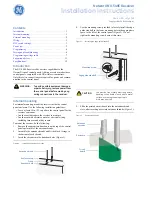Lexicon
IR Remote Connector (Sheet 18)
This page contains the IR detector input for ZONE 2.
ZONE 2 Remote Input
Remote control of the RV-8 is made possible via an infra-red detector behind the front panel lens. Control
from the Main Zone is made by pointing the remote at the front panel and activating functionality on the
remote control surface panel. Remote control for a second zone is made possible by connecting an IR
detector to J5. When commands from the remote strobe this external detector, the resultant signal is
passed along to an infra-red LED located in close proximity to the main zone detector. This LED is also
located behind the front panel lens. The result is that the serial commands made by the remote control
from ZONE 2 are repeated by the front panel IR LED which in turn are received by the front panel
detector. J5 is spark gap protected and diode clamped by D5 and D6. R25 and R26 form a voltage divider
to properly bias the IR LED.
Provision is made for a third zone of remote control, but this has not been implemented in this product. In
this case, signals passed along from the external detector via J6 activate IR LED D8 which are then
received by IR detector U1. Both components are located in close proximity inside the unit chassis. The
output from the detector is passed along to the AVRX FPGA for further processing and signal
conditioning.
Bypass Capacitors (Sheet 19)
This page illustrates the distribution of capacitive de-coupling for each of the supply voltage zones. Of the
six voltage planes used in this project, the 3.3VD supply is larger because a far larger percentage of the
design uses 3.3V logic. This plane, therefore, has more in the way of high frequency de-coupling as well
as evenly distributed bulk capacitance.
The 5VD plane area is the next largest. It primarily supplies the Host CPU and its support memory.
The 1.8V planes are for the core voltages used by the Hammerhead SHARCs.
The 2.5V plane area supplies the core voltages for the AVRX as well as the Format Decoder.
The +/-15V supplies are used exclusively by the two PLL circuits.
RV-8 PHONO / MICROPHONE INPUT BOARD THEORY
The Phono / Microphone Input Board contains the circuitry for the phono and mic input preamplifiers.
This board is located in a metal tray with the Tuner Board attached to the back panel.
The outputs from the preamps are sent to the Analog Board via a flat flex cable and eventually to
differential buffers on that board. All unbalanced “+” signals are sent with a local ground reference as a
“–” to form a differential pair.
Phono Inputs
The phono is designed as a two stage RIAA filter circuit. The first operational amplifier takes care of the
50Hz and 500Hz breakpoints, while the 2122Hz rolloff is accomplished by the passive network R35, R44,
and C37. The second amplifier supplies an additional 19.5 dB of gain. Using two amplifiers results in
accurate conformance to the RIAA curve as well as lower distortion due to the fact that each amplifier is
operating at a lower gain than would be the case in a single-amplifier design.
6-47
Summary of Contents for RV-8
Page 8: ......
Page 18: ...RV 8 Service Manual 3 6 ...
Page 54: ......
Page 76: ......
Page 132: ......
Page 156: ......
Page 157: ......
Page 158: ......
Page 159: ......
Page 160: ......
Page 161: ......
Page 162: ......
Page 163: ......
Page 164: ......
Page 165: ......
Page 166: ......
Page 167: ......
Page 168: ......
Page 169: ......
Page 170: ......
Page 171: ......
Page 172: ......
Page 173: ......
Page 174: ......
Page 175: ......
Page 176: ......
Page 177: ......
Page 178: ......
Page 179: ......
Page 180: ......
Page 181: ......
Page 182: ......
Page 183: ......
Page 184: ......
Page 185: ......
Page 246: ......
Page 247: ......


















